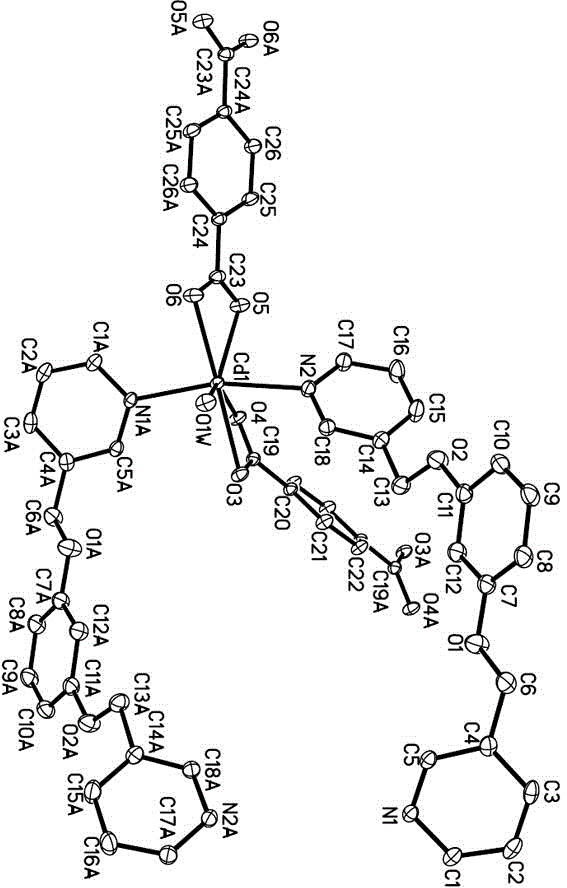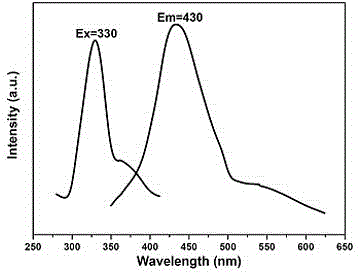Cadmium coordination polymer as well as preparation method and applications thereof
A cadmium coordination polymer and a technology for coordination polymers are applied in the field of chemistry to achieve the effects of stable fluorescence performance, high yield, and simple preparation method and process.
- Summary
- Abstract
- Description
- Claims
- Application Information
AI Technical Summary
Problems solved by technology
Method used
Image
Examples
preparation example Construction
[0013] A kind of preparation method of cadmium coordination polymer, described preparation method comprises the following steps: dihydrate cadmium acetate, 1,4-benzenedicarboxylic acid, 1,3-bis(pyridine-3-methoxy)benzene Put into the reactor with distilled water, after closing, react at 150 ℃ for 4 days; Dry naturally in the air, and further, the molar ratio of the reactants is: cadmium acetate dihydrate: 1,4-benzenedicarboxylic acid: 1,3-bis(pyridine-3-methoxy)benzene=2:1: 1. The number of liters of distilled water is 100 times the number of moles of cadmium acetate dihydrate.
[0014] An application of a cadmium coordination polymer, the application of the cadmium coordination polymer on fluorescent materials.
Embodiment 1
[0015] Embodiment 1: the synthesis of coordination polymer:
[0016] Cadmium acetate dihydrate (11 mg, 0.04 mmol), 1,4-benzenedicarboxylic acid (3 mg, 0.02 mmol), 1,3-bis(pyridine-3-methoxy)benzene (6 mg, 0.02 mmol) and 4mL of distilled water into the reactor, closed, and reacted at 150°C for 4 days; after the reaction was completed, the temperature was lowered at a rate of 5°C / h until room temperature, and colorless blocky crystals were collected and dried naturally in the air , to obtain cadmium coordination polymers. The yield is about 51%. The synthetic method is reliable and stable through repeated tests.
Embodiment 2
[0017] Example 2: Characterization of coordination polymers:
[0018] Structural determination of coordination polymers: select single crystals of appropriate size under a microscope to conduct X-ray diffraction experiments at room temperature. On a Bruker Smart Apex-II CCD diffractometer, Mo–K αRays (wavelength = 0.71073 ?), collect diffraction data in the φ–ω manner. Data restoration was performed with the Bruker SAINT program. Diffraction data for partial structures were corrected for absorption using the SADABS program. The crystal structure was solved by direct method combined with difference Fourier synthesis. The coordinates and anisotropy parameters of all non-hydrogen atoms were corrected by the full matrix least squares method, and the positions of C–H and O–H atoms were calculated and determined according to the theoretical model. The detailed crystal determination data are shown in Table 1. For the crystal structure of coordination polymers see figure 2 , ...
PUM
 Login to View More
Login to View More Abstract
Description
Claims
Application Information
 Login to View More
Login to View More - R&D
- Intellectual Property
- Life Sciences
- Materials
- Tech Scout
- Unparalleled Data Quality
- Higher Quality Content
- 60% Fewer Hallucinations
Browse by: Latest US Patents, China's latest patents, Technical Efficacy Thesaurus, Application Domain, Technology Topic, Popular Technical Reports.
© 2025 PatSnap. All rights reserved.Legal|Privacy policy|Modern Slavery Act Transparency Statement|Sitemap|About US| Contact US: help@patsnap.com



